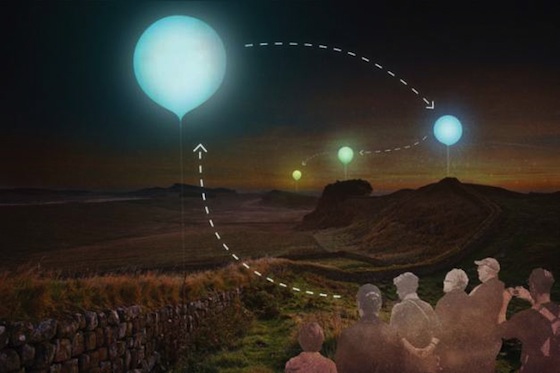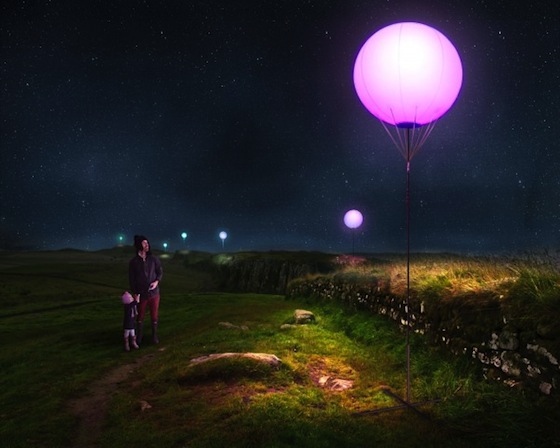A group of American artists is using 450 balloons and thousands of light emitting diodes to turn the 2,000-year-old Hadrian’s Wall into the world’s longest work of art.

Background
A group of American artists is using 450 balloons and thousands of light emitting diodes to turn the 2,000-year-old Hadrian’s Wall into the world’s longest work of art.
The New York based digital artists collective called “YesYesNo” was invited by organizers of Britain’s Olympic-themed summer arts festival.
Details of the temporary public art project, which is called Connecting Light, emerged at the launch of the nationwide London 2012 Festival celebrating the Olympic and Paralympic Games.

From August 31 through September 1, 2012, “Connecting Light” will be live and suspend hundreds of white weather balloons above the 73-mile (117- kilometer) wall. The wall and the lights will snakes across hill and dale in northern England just south of the Scottish border.
What was once a protective border is transformed into a line of communication.
Using a series of tethered balloons and lit by internal LED lights, the installation becomes a line of pulsating colors.
Not only fitted with lights, ballons will be networked so they can communicate with one another. The changing colors respond to messages sent across the wall. Viewers will be able to submit short messages which will be transformed into pulses of colored light that pass along the wall in patterns reminiscent of Morse Code.
Messages sent across the wall can be made visible through smartphones, iPads and tablets and detailed information will be available at a number of visitor sites. Visitors will be able to see stretches of the wall from spots along the route, while people around the world can watch on the Internet.

The idea of internally lit weather balloons tethered along the line of the Unesco World Heritage Site will spark memories of the Illuminating Hadrian’s Wall project two years ago when beacons were lit at intervals along its length.
YesYesNo
YesYesNo founding member Zachary Lieberman, who will oversee the final work on the project at Newcastle University in northeast England, said he hoped to create “the inverse of a border … to imagine the border as a means of connection” rather than separation.
Lieberman said balloons were chosen for their ability to evoke a sense of wonder and magic. “It’s really amazing, going from rural to rugged and urban, and that’s really interesting. One thing that appealed to us about this project was the scale of it and also that diversity.”
“Our concept is to create a digital platform by which messages can be communicated the entire length of the Wall,” he said.
“The goal is to understand the Wall in a modern context and imagine it not as a barrier but as a bridge, as a means of connecting rather than dividing.”
Linda Tuttiett, chief executive of Hadrian’s Wall Heritage, said: “Connecting Light will turn what was the Roman Empire’s northern frontier into a contemporary communication system.
“We want to inspire a worldwide conversation of people’s thoughts on all aspects of borders and frontiers in their lives today.”